What does Ripple’s battle with the SEC mean for the crypto industry?
.webp)


This Week in Crypto
Markets have reacted in a polarized manner to the debt ceiling standoff in the US, as regulators scurry to reach an agreement this week. Bitcoin and Ethereum fell by 1.31% and 0.09% respectively over the past week, while Ethereum rose in TVL by 2.18%. The biggest winners of last week’s rally were Cardano, Polygon, and Aave. However, the increase in TVL on the last two protocols could be attributed to a bug on Aave v2 on Polygon that left over $100M stuck in smart contracts, which is due to the ReserveInterestRateStrategy smart contract deployed on Ethereum’s scalability solution, according to BlockSec. The bug is slated to be fixed after the vote on a proposal within the Aave ecosystem is complete.
Figure 1: Price and TVL Developments of Major Crypto Sectors
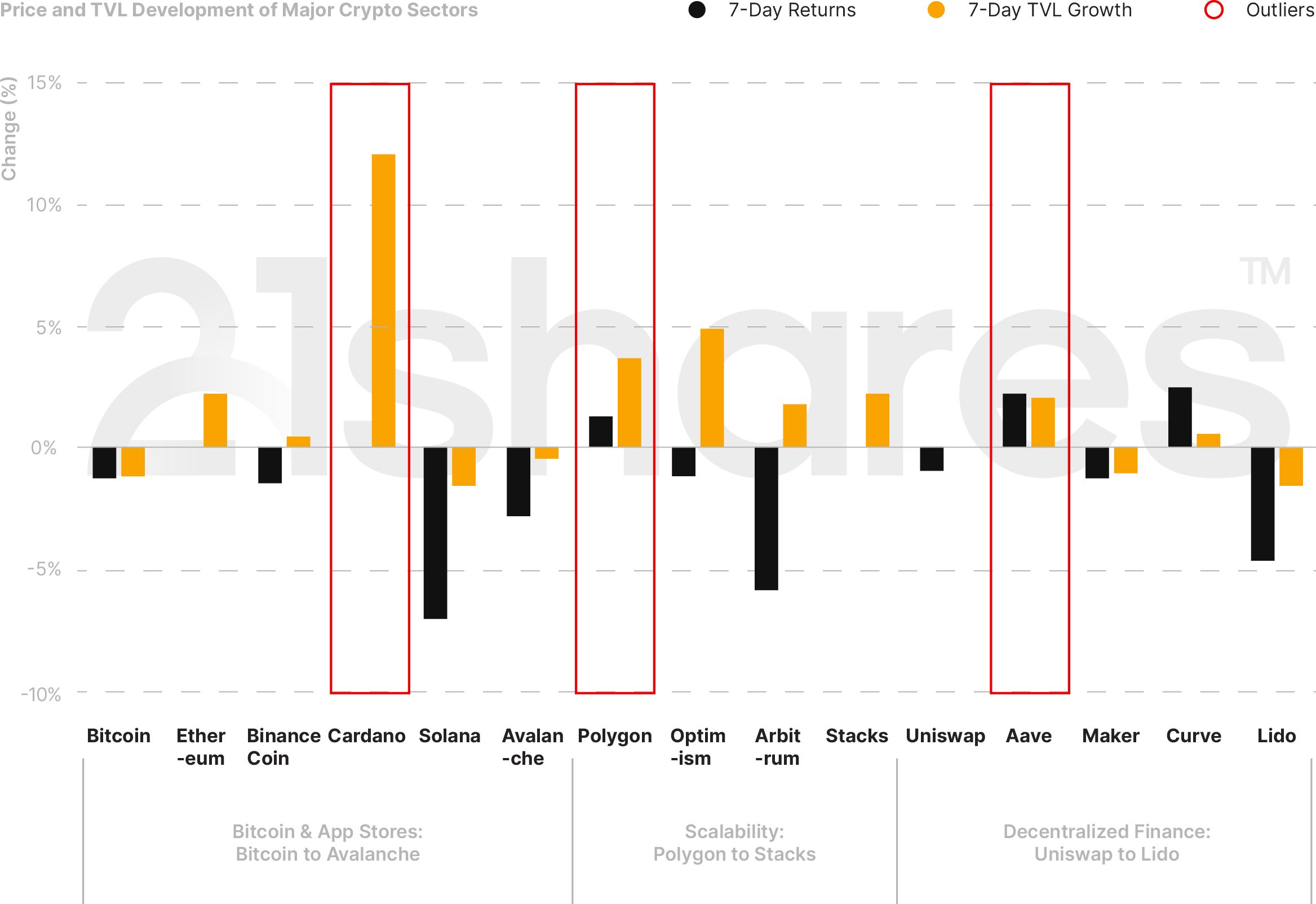
Source: Coingecko, DeFi Llama. Close data as of May 22, 2023.
Key takeaways:
- Ripple jumps by almost 8% over the past week on the back of legal wins in its long battle with the US securities regulator. Also acquires Swiss fintech Metaco to weather regulatory headwinds in the US.
- Visa deploys 2 smart contracts on Ethereum to test a new technology designed to help the network become more user-friendly.
- Tether to buy more BTC with net profits, Galaxy Digital Executes the First Fully Onchain Options OTC Trade on Ethereum.
- Ubisoft reminds Web3 of its confidence in the space with Assassin’s Creed NFTs on Polygon.
Spot and Derivatives Markets
Figure 2: Futures Long Liquidations Dominance

Source: Glassnode
Liquidations of long futures contracts have been dominant over the past week, as investors look to realize profits in fear that Bitcoin’s price would drop in light of the macro headwinds led by the debt ceiling standoff and the implications it has on the banking industry.
On-chain Indicators
Figure 3: Lido’s Upgrade Echoes Success
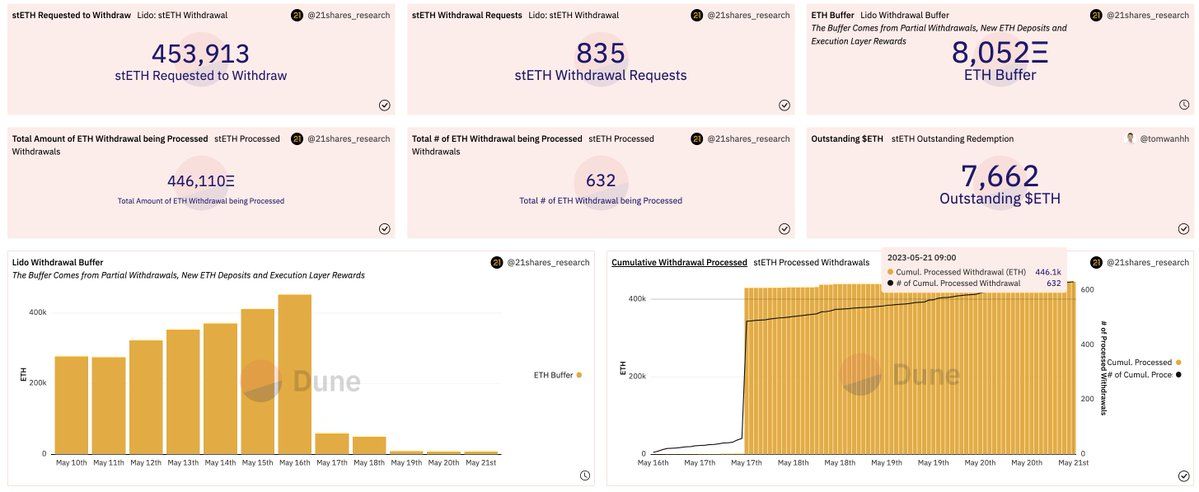
Source: 21shares on Dune Analytics
Celsius withdrew over $800M from Lido last week, right after the staking protocol’s upgrade. With Lido being the largest DeFi app on Ethereum, our dashboards show that the staking protocol executed the staked ETH withdrawals flawlessly to avoid putting additional stress on the activation queue or exit queue using the buffer they had from the execution layer reward/daily deposits/partial withdrawals. As shown in Figure 1, Lido has performed the worst among its top peers within DeFi over the past week, this could be attributed to the drop in Ethereum’s price and additional speculation around Lido’s recent governance proposal, which we go into detail in the DeFi section later in this report.
Macro and Regulations
The debt ceiling impasse in the US continued to take a toll on the markets: House Speaker Kevin McCarthy and President Joe Biden started the debt ceiling talks to decide whether they’re extending the debt ceiling deadline, set for June 1st, or raising the borrowing limit as per McCarthy’s plea. They have to reach an agreement this week; otherwise, the U.S. economy will fall to catastrophic measures. The weekly performance for tech stocks is almost like the calm before the potential storm. While S&P 500 (5D +1.36%) and Nasdaq Composite (5D +2.88%) soared in optimism, the debt ceiling noise dragged the Dow Jones Industrial Average down by only 0.18%. Although US bank indices are performing better than all three aforementioned baskets, 46% of US banks are tightening lending standards, according to the Federal Reserve’s April 2023 edition of the Senior Loan Officer Opinion Survey on Bank Lending Practices. As crypto decouples from tech stocks, the banking crisis in the US is still influencing the selling pressure of some cryptoassets.
Figure 4: Banks are Tightening Credit

Source: Federal Reserve
Ripple v. SEC: The court denied the motion of the Securities and Exchanges Commission (SEC) to seal the 2018 speech by former Division of Corporation Finance Director William Hinman as part of Ripple’s filings against the stance of the securities regulator. For the second time, the SEC sent a motion to seal the speech, which alludes to the point that Bitcoin and Ethereum are not investment contracts. In the speech given at the Yahoo Finance All Markets Summit, Hinman also acknowledged the potential for cryptoassets to evolve from being initially sold as investment contracts to later being classified as commodities when the network of a given asset has matured.
The legal dispute between Ripple and the SEC dates back to 2020 when the securities regulator accused the company of selling unregistered securities, represented by XRP, which increased by around 8% over the past week. Although the verdict is yet to be made in June, this is an industry-wide win that could lead to much-needed legal clarity around the definition of cryptoassets in the eyes of the law.
In other good news for Ripple; strengthening its brand as a cross-border payments solution: The company is building a platform for CBDC issuance for governments to maintain the lifecycle of their digital currencies. Considering that XRP is a de facto rival to SWIFT for many banks around the world, this helps paint Ripple as a mature network for financial institutions to trust and therefore making the case of the SEC likely more difficult to sustain. Ripple has also acquired Metaco, a Swiss fintech company focused on digital asset operations. This could be deemed as a tactic to capitalize on the company’s offshore operations to mitigate the regulatory crackdown in the U.S. that has been pushing crypto companies abroad. With Europe’s Markets in Crypto Assets ratified and ready for execution as of next year, French regulators did not shy away from raising the “refugees welcome” flag for companies in the crypto industry fleeing the US.
Crypto Infrastructure
Bitcoin Lightning Labs, the company behind Bitcoin’s scaling solution, the Lightning Network, unveiled the latest network upgrade. Previously known as Taro Assets, the solution leverages the Bitcoin Taproot upgrade for asset issuance on top of Bitcoin. That said, the advent of the new upgrade dubbed Taro Assets 0.2 (Daemon), will help Bitcoin users migrate their assets from the mainnet layer onto the Lightning network. The network optimization should help reduce gas costs for issuing and transferring new assets while expediting the transaction settlement.
The update is crucial as BRC20, Ordinals, and the recent smart-contract innovations have congested Bitcoin due to the unprecedented demand on its limited blockspace. Thus, offloading the demand to scaling solutions should help the network become affordable for the average user. Finally, akin to Bitcoin Cash and Litecoin efforts in replicating Bitcoin’s asset issuance capabilities, dogecoin has adopted a similar standard, DRC20, to experiment with creating fungible assets on top of the blockchain. This is important as the contagion of the ordinal's success spreads to the rest of legacy payment networks and helps them find innovative use cases for their blockchain.
Figure 5: BTC, LTC, DOGE Daily # of Transactions

Source: bitinfocharts.com
Visa deployed two emulated applications on the Ethereum testnet in a push to advance its experiment with account abstraction (AA). The network upgrade introduced in March helps users have a smarter wallet that offers a more user-intuitive experience reminiscent of Fintech banking. Dubbed pay-master smart-contract, the deployed smart contracts could sponsor translation fees in one instance and help users pay with an alternative ERC20 token for the gas fees in another, like dollar-backed stablecoins or CBDC. Visa's experiment marks a monumental milestone in offering the required groundwork to facilitate the onboarding of millions of users into the digital asset ecosystem. By offering railways that conceal the complexities of blockchain technology, AA implementations provide a seamless transition for individuals entering crypto.
Cosmos is poised to enhance its security infrastructure by introducing Mesh Security. Spearheaded by Osmosis, the largest exchange on the Cosmos network, this initiative aims to strengthen the security of application-specific protocols within the Cosmos ecosystem by consolidating the combined individual stakes. This cross-chain security model draws inspiration from the NATO alliance, emphasizing collective defense. By joining this collaborative effort, participating projects can pool their staked tokens, providing enhanced security guarantees and directly defending other chains in the network.
In contrast to the Replicated-Security model, which offers a top-down approach to emerging applications that lack the resources to establish their security, Mesh Security is specifically tailored for existing applications seeking to collaborate and reinforce their economic security amongst each other. The proposal is set to be implemented in three stages, with the final phase scheduled for completion in the first quarter of the following year. Although the model will introduce additional risks to existing validators hoping to generate additional revenue, it is still a worthy ambition to heighten the security of Cosmos.
Decentralized Finance
Figure 6: Weekly Performance of Major DeFi Apps
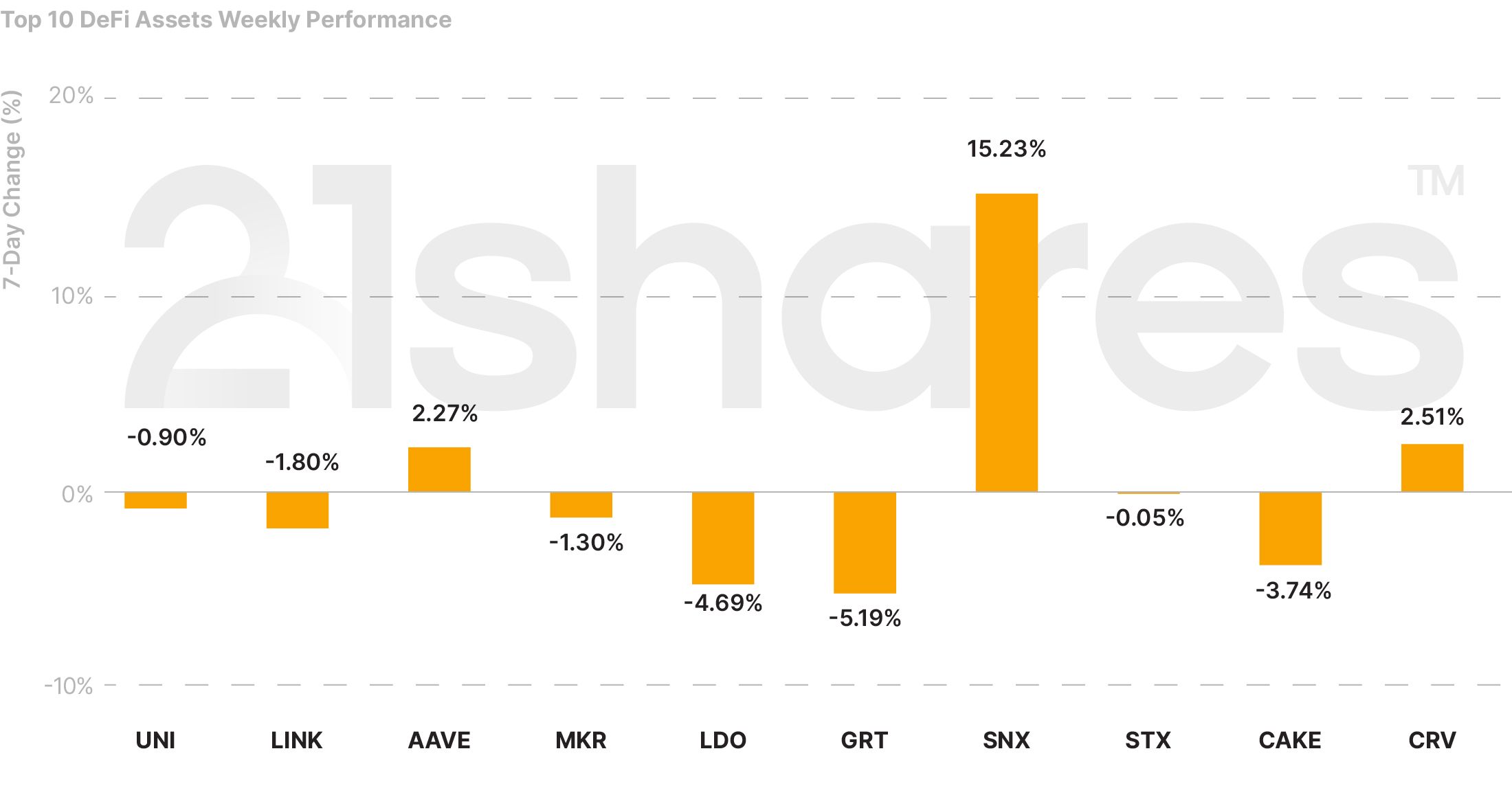
Source: Coingecko. Close data as of May 22, 2023.
Stablecoins
Tether, the issuer of the USDT stablecoin, revealed it’d purchase more Bitcoin with its net operating profit accrued from its customer’s held deposits. The announcement, which will amplify Tether’s 2% allocation into Bitcoin, comes a week after Tether shared its assurance report showing the company’s reserves backing the largest stablecoin by market capitalization. The decision to continually reinvest further profits into BTC throughout the year should help Tether build a war chest that gives it more runaway in the long term as well as serve as a cushion for the expected selling pressure that will emanate from claimants of Mt Gox and the US government auction off the seized assets from the silk road case.
Ethereum ecosystem
The Lido Finance community is discussing a proposal to introduce a revenue-sharing mechanism where users can stake their assets and earn a portion of the Lido DAO treasury revenue. The distribution of rewards would be weekly, and there would be a vesting period of at least six months. This move by Lido, the largest DeFi protocol by AUM, could set a precedent for profit-sharing among token holders in the DeFi industry. However, the proposal will likely not pass due to concerns over the potential misuse of the DAO's treasury without adequate incentives for network growth and exposing the protocol to regulatory scrutiny.
Galaxy Digital, the US-based digital asset manager, executed its first options trade fully on-chain. The company leveraged Ribbon’s finance solution focused on bilateral options trades known as Aevo OTC. The solution enabled Galaxy to execute and settle the agreement via an OTC trade with investment firm Coinfund, with Aevo’s smart contracts acting as an escrow and thus mitigating the credit risk that emerges in the traditional finance structure. This is a crucial milestone in the evolution of DeFi, as it inches the industry closer to replicating the critical services of Traditional Finance. Further, as Galaxy, amongst other firms, lost capital due to the failed counterparties embroiled in the FTX collapse, leveraging an immutable, unbiased, and neutral settlement layer proved its reliability as alternative financial railways. Finally, the development should drive deeper liquidity into the DeFi space as all the volume is currently concentrated on the centralized venues, as shown below.
Figure 7: Volume of ETH options
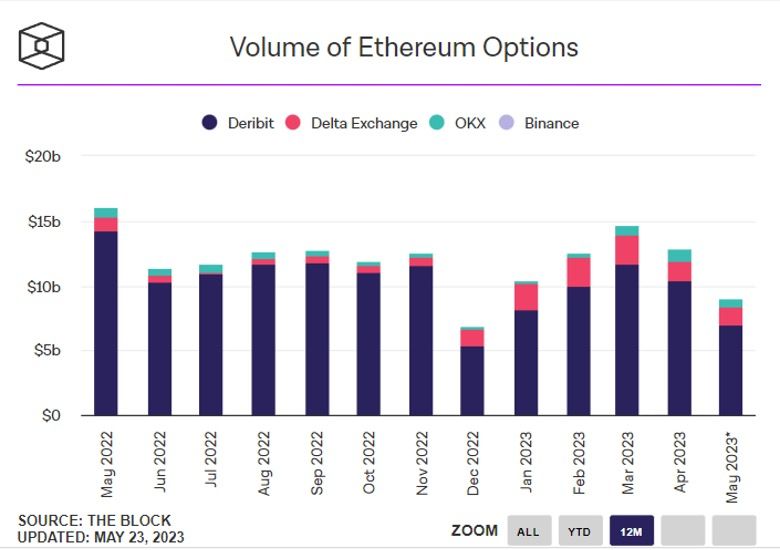
Source: The Block
NFTs and Metaverse
Figure 8: Number of Ordinal Inscriptions
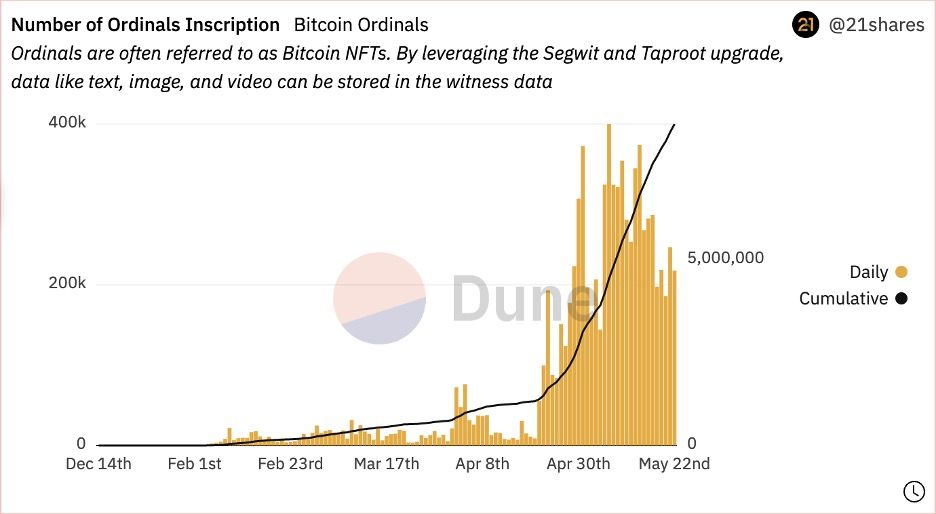
Source: 21shares on Dune Analytics
Bitcoin’s burgeoning Web3: While the hype over Ordinals is not cooling down, with the cumulative inscriptions on a steady high, as shown in Figure 7, more protocols are building to capture this traction. DIBA, a new Bitcoin NFT marketplace, went live last week, utilizing the Really Good for Bitcoin (RGB) smart contracts built on the growing scalability solutions of Bitcoin. The RGB protocol also helps ease congestion on the Bitcoin network and provides a more private method for BTC transactions. DIBA has also partnered with crypto miner Hut 8 Mining to launch their Bitcoin-exclusive wallet, which can also store music files and art. The developments on the Bitcoin blockchain are nothing short of exciting and are thus the most fundamental leading indicator for the asset’s promising future. Although macro headwinds could be taking a toll on the price movement in the relatively short run, builders will nevertheless highlight Bitcoin’s amplifying utility and, therefore, the cryptoasset’s value proposition in the long term.
GameFi leaps towards mass adoption: Last week also witnessed an integration between the crypto and traditional players in both directions. Sky Mavis’ Axie Infinity went live on the App Store in its effort to tap into the 1.36B iPhone users following its launch on Google Play Store back in December 2022. On the opposite side of the table, Assassin’s Creed announced that it is tying NFTs on Polygon with 3D physically printed items. Ubisoft, Assassin’s Creed’s publisher, has been the most active among its competitors in the space in the Web3 world. Back in February, the gaming giant minted NFT avatars for its game Rabbids on the gaming-focused, Ethereum-powered metaverse, The Sandbox. In December 2021, Ubisoft was also the first major gaming publisher to release in-game NFT items with Ghost Recon Breakpoint, and although the traction wasn’t very encouraging, they did not shy away from pushing more projects on Web3. Ubisoft’s confidence in Web3 is fascinating, considering it is not a company that merely needs more traction, although it shows that gaming giants want to stay not only relevant but also first-movers in the space to capitalize on this advantage.
Next Week’s Calendar
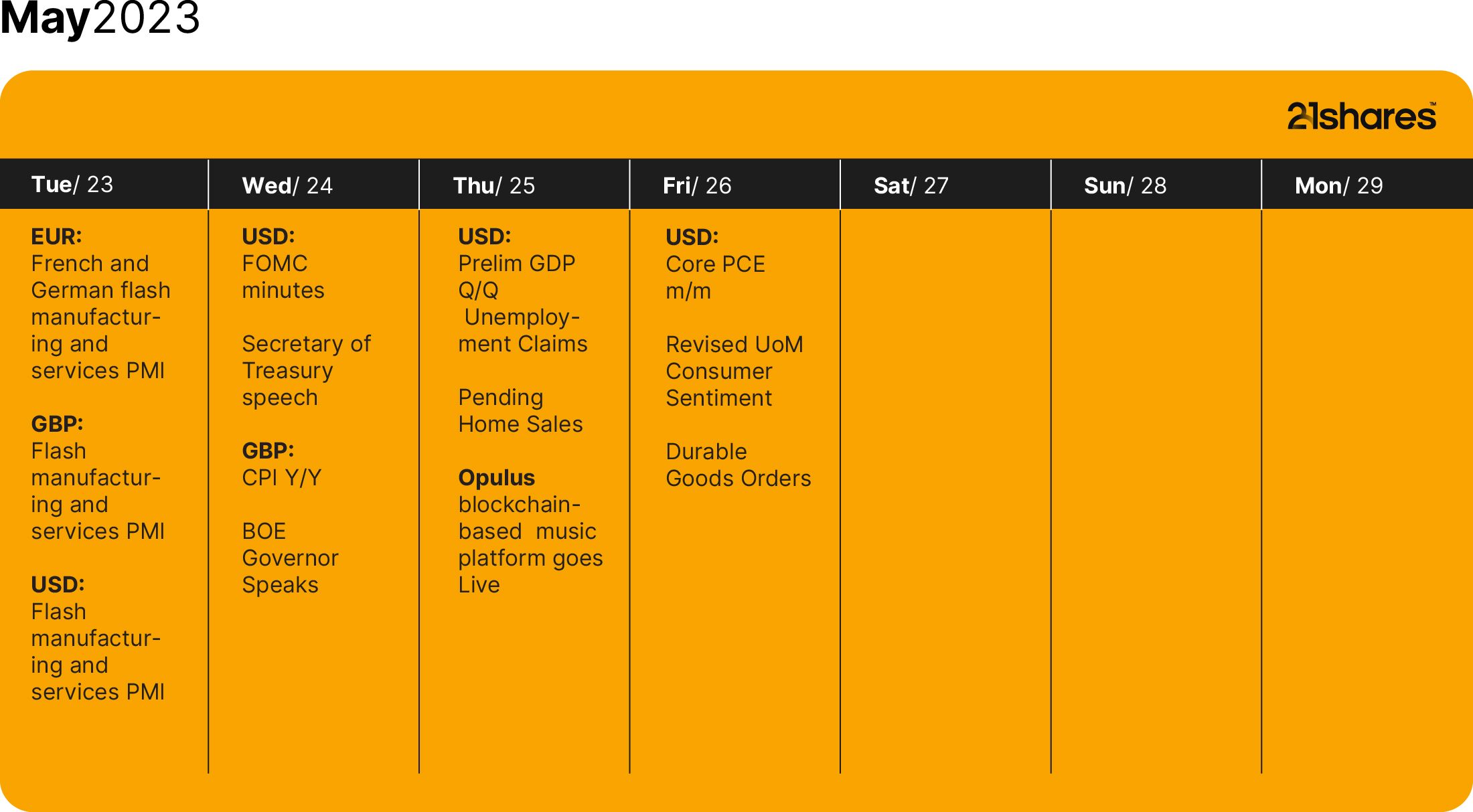
Disclaimer
The information provided does not constitute a prospectus or other offering material and does not contain or constitute an offer to sell or a solicitation of any offer to buy securities in any jurisdiction. Some of the information published herein may contain forward-looking statements. Readers are cautioned that any such forward-looking statements are not guarantees of future performance and involve risks and uncertainties and that actual results may differ materially from those in the forward-looking statements as a result of various factors. The information contained herein may not be considered as economic, legal, tax or other advice and users are cautioned to base investment decisions or other decisions solely on the content hereof.

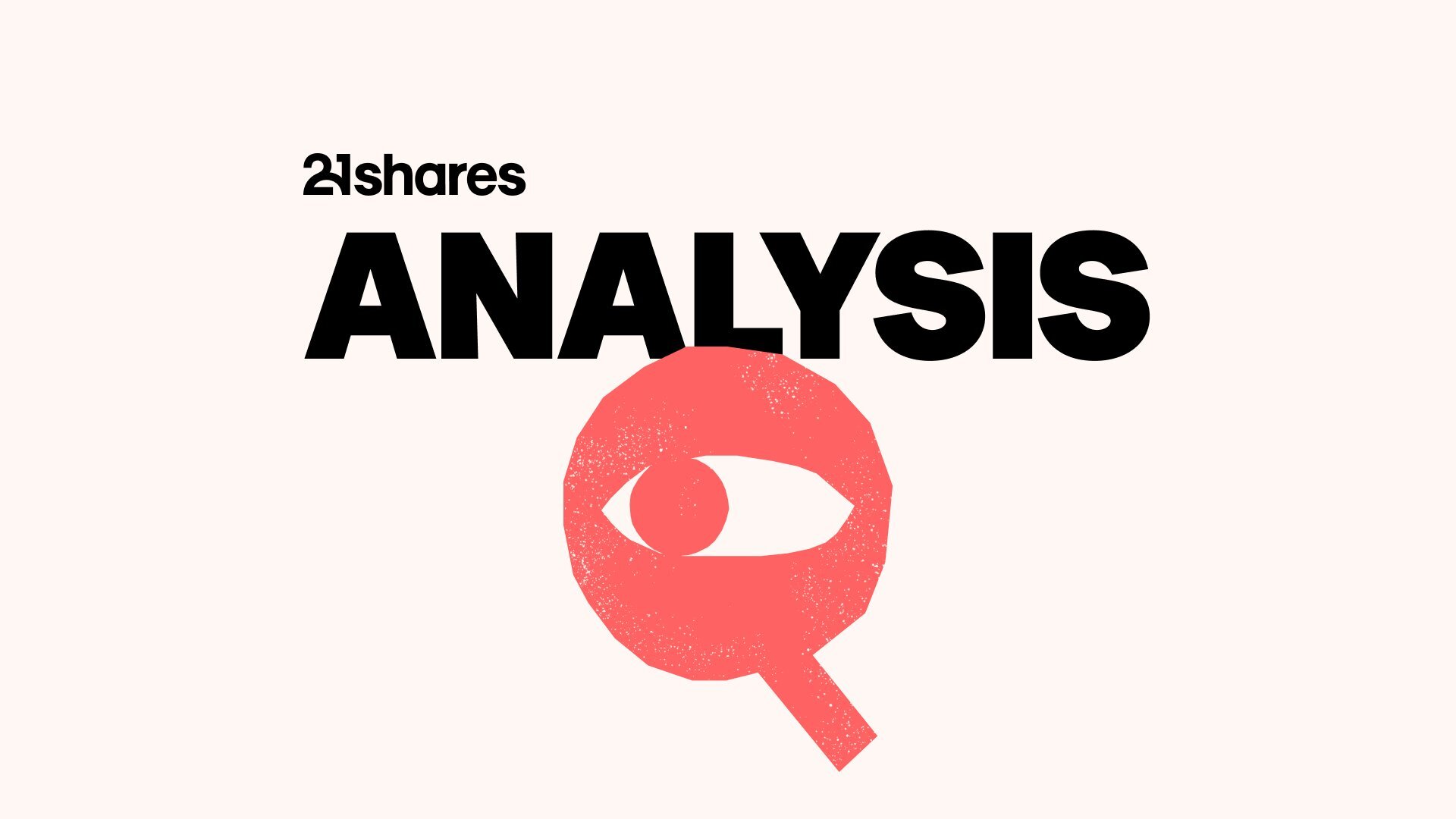







_logo.svg)

.svg.png)